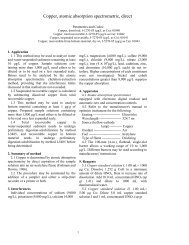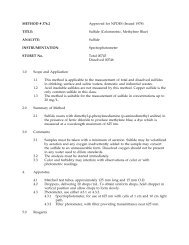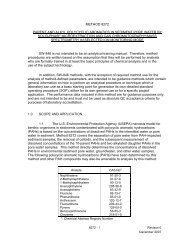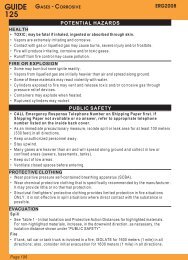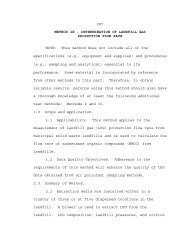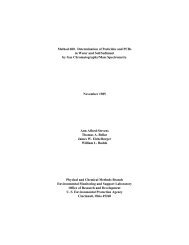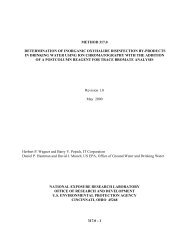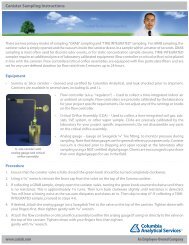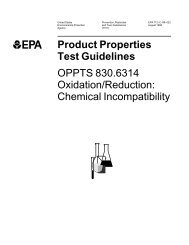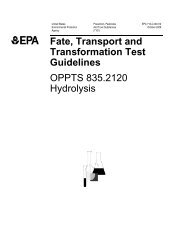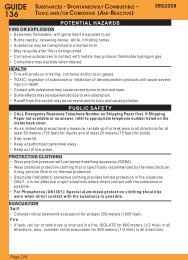View Actual EPA Method 8081A (PDF File)
View Actual EPA Method 8081A (PDF File)
View Actual EPA Method 8081A (PDF File)
You also want an ePaper? Increase the reach of your titles
YUMPU automatically turns print PDFs into web optimized ePapers that Google loves.
7.5.11 Identification of mixtures (i.e. Chlordane and Toxaphene) is based on thecharacteristic "fingerprint" retention time and shape of the indicator peak(s); and quantitationis based on the area under the characteristic peaks as compared to the area under thecorresponding calibration peak(s) of the same retention time and shape generated using eitherinternal or external calibration procedures.7.5.12 If compound identification or quantitation is precluded due to interference (e.g.,broad, rounded peaks or ill-defined baselines are present) cleanup of the extract orreplacement of the capillary column or detector is warranted. Rerun the sample on anotherinstrument to determine if the problem results from analytical hardware or the sample matrix.Refer to <strong>Method</strong> 3600 for the procedures to be followed in sample cleanup.7.6 Quantitation of multi-component analytes - Multi-component analytes present problemsin measurement. Suggestions are offered in the following sections for handing Toxaphene,Strobane, Chlordane, BHC, and DDT.7.6.1 Toxaphene and Strobane - Toxaphene is manufactured by the chlorination ofcamphenes, whereas Strobane results from the chlorination of a mixture of camphenes andpinenes. Quantitation of Toxaphene or Strobane is difficult, but reasonable accuracy can beobtained. To calculate Toxaphene from GC/ECD results:7.6.1.1. Adjust the sample size so that the major Toxaphene peaks are 10-70%of full-scale deflection (FSD).7.6.1.2 Inject a Toxaphene standard that is estimated to be within ± 10 ng ofthe sample amount.7.6.1.3 Quantitate Toxaphene using the total area of the Toxaphene pattern orusing 4 to 6 major peaks.7.6.1.3.1 While Toxaphene contains a large number of compoundsthat will produce well resolved peaks in a GC/ECD chromatogram, it alsocontains many other components that are not chromatographically resolved. Thisunresolved complex mixture results in the "hump" in the chromatogram that ischaracteristic of this mixture. Although the resolved peaks are important for theidentification of the mixture, the area of the unresolved complex mixturecontributes a significant portion of the area of the total response.7.6.1.3.2 To measure total area, construct the baseline ofToxaphene in the sample chromatogram between the retention times of the firstand last eluting Toxaphene components in the standard. In order to use the totalarea approach, the pattern in the sample chromatogram must be compared tothat of the standard to ensure that all of the major components in the standardare present in the sample. Otherwise, the sample concentration may besignificantly underestimated.7.6.1.3.3 Toxaphene may also be quantitated on the basis of 4 to6 major peaks. A collaborative study of a series of Toxaphene residuesevaluated several approaches to quantitation of this compound, including the useof the total area of the peaks in the Toxaphene chromatogram and the use of asubset of 4 to 6 peaks. That study indicated that the use of 4 to 6 peaks providesCD-ROM <strong>8081A</strong> - 17 Revision 1December 1996



